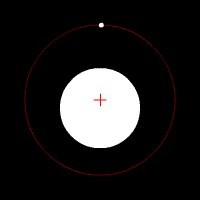ÕÅŹõĮ£ńö©ÕÅżÕģĖÕŖøÕŁ”Ńü«ŃāŗŃāźŃā╝ŃāłŃā│Ńü«ķüŗÕŗĢµ│ĢÕēćŃü«3ńĢ¬ńø«Ńü¦Ķ¬¼µśÄŃüĢŃéīŃü”ŃüäŃéŗŃéłŃüåŃü½ŃĆüÕģ©Ńü”Ńü«ÕŖøŃü»ŃāÜŃéóŃü½Ńü¬ŃüŻŃü”ńö¤ŃüśŃĆü1ńĢ¬ńø«Ńü«ńē®õĮōŃüī2ńĢ¬ńø«Ńü«ńē®õĮōŃüĖÕŖøŃéÆÕÅŖŃü╝ŃüÖŃü©ŃĆü2ńĢ¬ńø«Ńü«ńē®õĮōŃü»µ£ĆÕłØŃü«ńē®õĮōŃü½ńŁēŃüŚŃüäÕÅŹÕ»ŠŃü«ÕŖøŃéÆÕÅŖŃü╝ŃüÖ[1][2]ŃĆéń¼¼3µ│ĢÕēćŃü»ŃéłŃéŖõĖĆĶł¼ńÜäŃü½Ńü»ŃĆīÕģ©Ńü”Ńü«õĮ£ńö©Ńü½Õ»ŠŃüŚŃü”ŃĆüÕĖĖŃü½ńŁēŃüŚŃüäÕÅŹõĮ£ńö©ŃüīÕŁśÕ£©ŃüÖŃéŗŃĆéŃüŠŃü¤ŃĆü2ŃüżŃü«ńē®õĮōŃü«ńøĖõ║ÆõĮ£ńö©Ńü»ÕĖĖŃü½ńŁēŃüŚŃüÅŃĆüÕÅŹÕ»ŠÕÉæŃüŹŃü¦ŃüéŃéŗŃĆŹŃü©ŃüäŃüå[3]ŃĆéŃü®ŃüĪŃéēŃéÆõĮ£ńö©Ńü©ŃüŚÕÅŹõĮ£ńö©Ńü©Ńü┐Ńü¬ŃüÖŃüŗŃü»õ╗╗µäÅŃü¦ŃüéŃéŗŃĆé2ŃüżŃü«ŃüåŃüĪŃüäŃüÜŃéīŃüŗŃéÆõĮ£ńö©Ńü©Ķ”ŗŃü¬ŃüÖŃüōŃü©ŃüīŃü¦ŃüŹŃéŗŃüīŃĆüŃééŃüå1ŃüżŃü»ķ¢óķĆŻŃüÖŃéŗÕÅŹõĮ£ńö©Ńü¦ŃüéŃéŗŃĆé õŠŗÕ£░ķØóŃü©Ńü«ńøĖõ║ÆõĮ£ńö©ŃüéŃéŗŃééŃü«ŃüīÕ£░ķØóŃü½ÕŖøŃéÆÕÅŖŃü╝ŃüŚŃü”ŃüäŃéŗŃü©ŃüŹŃĆüÕ£░ķØóŃééÕÅŹÕ»Šµ¢╣ÕÉæŃü«ÕÉīŃüśÕŖøŃü¦µŖ╝ŃüŚµł╗ŃüŚŃü”ŃüÅŃéŗŃĆéŃāÉŃéżŃé¬ŃāĪŃé½ŃāŗŃé»Ńé╣Ńü¬Ńü®Ńü«Õ┐£ńö©ńē®ńÉåÕŁ”Ńü«ńē╣Õ«ÜŃü«ÕłåķćÄŃü¦Ńü»ŃĆüŃüōŃü«Õ£░ķØóŃü½ŃéłŃéŗÕŖøŃü»ŃĆīÕ£░ķØóÕÅŹÕŖøŃĆŹŃü©Õæ╝Ńü░ŃéīŃĆüÕ£░ķØóŃü½ŃüéŃéŗńē®õĮōŃü½ŃéłŃéŗÕŖøŃü»ŃĆīõĮ£ńö©ŃĆŹŃü©Ķ”ŗŃü¬ŃüĢŃéīŃéŗŃĆé Ķ¬░ŃüŗŃüīŃéĖŃāŻŃā│ŃāŚŃüŚŃü¤ŃüäµÖéŃĆüŃüØŃü«õ║║Ńü»Õ£░ķØóŃü½õ╗śÕŖĀńÜäŃü¬õĖŗÕÉæŃüŹŃü«ÕŖøŃéÆÕŖĀŃüłŃéŗ’╝łŃĆīõĮ£ńö©ŃĆŹ’╝ēŃĆéÕÉīµÖéŃü½ŃĆüÕ£░ķØóŃü»õ║║Ńü½õĖŖÕÉæŃüŹŃü«ÕŖøŃéÆÕÅŖŃü╝ŃüÖ’╝łŃĆīÕÅŹõĮ£ńö©ŃĆŹ’╝ēŃĆéŃüōŃü«õĖŖÕÉæŃüŹŃü«ÕŖøŃüīõ║║Ńü«õĮōķćŹŃéłŃéŖŃééÕż¦ŃüŹŃüäÕĀ┤ÕÉłŃĆüõĖŖÕÉæŃüŹŃü«ÕŖĀķƤŃüīńö¤ŃüśŃéŗŃĆéŃüōŃéīŃéēŃü«ÕŖøŃüīÕ£░ķØóŃü½Õ×éńø┤Ńü¦ŃüéŃéŗÕĀ┤ÕÉłŃĆüŃüōŃéīŃéēŃü»Õ×éńø┤µŖŚÕŖøŃü©ŃééÕæ╝Ńü░ŃéīŃéŗŃĆé ÕÉīµ¦śŃü½ŃĆüĶ╗ŖõĖĪŃü«Õø×Ķ╗óŃüÖŃéŗĶ╗ŖĶ╝¬Ńü»Õ£░ķØóŃü«µ©¬ÕłćŃéŖÕŠīµ¢╣Ńü½µ╗æŃéŹŃüåŃü©ŃüÖŃéŗŃĆéÕ£░ķØóŃüīŃüéŃüŠŃéŖµ╗æŃéŖŃü½ŃüÅŃüäÕĀ┤ÕÉłŃĆüŃüōŃéīŃü½ŃéłŃéŖ1Õ»ŠŃü«µæ®µō”ÕŖøŃüīńö¤ŃüśŃéŗŃĆéĶ╗ŖĶ╝¬Ńü½ŃéłŃéŗÕ£░ķØóŃü½Õ»ŠŃüÖŃéŗÕŠīµ¢╣ŃüĖŃü«ŃĆīõĮ£ńö©ŃĆŹŃü©ŃĆüÕ£░ķØóŃü½ŃéłŃéŗĶ╗ŖĶ╝¬Ńü½Õ»ŠŃüÖŃéŗÕēŹµ¢╣ŃüĖŃü«ŃĆīÕÅŹõĮ£ńö©ŃĆŹŃü¦ŃüéŃéŗŃĆéŃüōŃü«ÕēŹµ¢╣ŃüĖŃü«ÕŖøŃüīĶ╗ŖĶ╝¬ŃéÆķĆ▓ŃüŠŃüøŃéŗŃĆé ķćŹÕŖø Õ£░ńÉāŃü»õ╗¢Ńü«µāæµś¤ÕÉīµ¦śÕż¬ķÖĮŃéÆÕæ©Õø×ŃüÖŃéŗŃĆéŃüōŃéīŃü»ŃĆüÕż¬ķÖĮŃü»ÕÉæÕ┐āÕŖøŃü©ŃüŚŃü”ÕāŹŃüÅÕ╝ĢÕŖøŃéÆÕÅŖŃü╝ŃüŚŃĆüŃüōŃü«ÕŖøŃüīŃü¬ŃüæŃéīŃü░Õ«ćÕ«ÖŃü½ķŻøŃü│Õć║ŃüŚŃü”ŃüŚŃüŠŃüåÕ£░ńÉāŃéÆõ┐صīüŃüŚŃü”ŃüäŃéŗŃüŗŃéēŃü¦ŃüéŃéŗŃĆéÕż¬ķÖĮŃü«Õ╝ĢÕŖøŃéÆõĮ£ńö©Ńü©Ńü┐Ńü¬ŃüÖÕĀ┤ÕÉłŃĆüÕÉīµÖéŃü½Õ£░ńÉāŃü»Õż¬ķÖĮŃüĖÕ╝ĢÕŖøŃéÆÕÅŖŃü╝ŃüŚŃü”ŃüäŃéŗŃĆéÕ£░ńÉāŃü«Õ╝ĢÕŖøŃü»Õż¬ķÖĮŃü©ÕÉīŃüśÕż¦ŃüŹŃüĢŃü¦ŃüéŃéŗŃüīÕÅŹÕ»Šµ¢╣ÕÉæŃü¦ŃüéŃéŗŃĆéÕż¬ķÖĮŃü«Ķ│¬ķćÅŃü»Õ£░ńÉāŃü«Ķ│¬ķćÅŃéłŃéŖŃééŃüÜŃüŻŃü©Õż¦ŃüŹŃüäŃü¤ŃéüŃĆüµÖ«ķĆÜÕż¬ķÖĮŃü»Õ£░ńÉāŃü«Õ╝ĢÕŖøŃü½ÕÅŹÕ┐£ŃüÖŃéŗŃéłŃüåŃü½Ńü»Ķ”ŗŃüłŃü¬ŃüäŃüīŃĆüÕ«¤ķÜøŃü½Ńü»ŃéóŃāŗŃāĪŃā╝ŃéĘŃā¦Ńā│Ńü¦ńż║ŃüĢŃéīŃéŗŃéłŃüåŃü½’╝łµŁŻńó║Ńü¬ńĖ«Õ░║Ńü¦Ńü»Ńü¬ŃüäŃüī’╝ēÕÅŹÕ┐£ŃüŚŃü”ŃüäŃéŗŃĆéõĖĪµ¢╣Ńü«Õż®õĮōŃü«ńĄÉÕÉłŃüŚŃü¤ķüŗÕŗĢŃéÆĶ¬¼µśÄŃüÖŃéŗµŁŻŃüŚŃüäµ¢╣µ│Ģ’╝łŃü©ŃéŖŃüéŃüłŃüÜõ╗¢Ńü«Õģ©Ńü”Ńü«Õż®õĮōŃéÆńäĪĶ”¢ŃüÖŃéŗ’╝ēŃü»ŃĆüõĖĪµ¢╣Ńü©ŃééńĄÉÕÉłŃüŚŃü¤ń│╗Ńü«Ķ│¬ķćÅõĖŁÕ┐ā’╝łÕż®µ¢ćÕŁ”Ńü½ŃüŖŃüäŃü”Ńü»barycenterŃü©Õæ╝Ńü░ŃéīŃéŗ’╝ēŃü«Õæ©ŃéŖŃéÆÕæ©Õø×ŃüÖŃéŗŃü©ŃüäŃüåŃééŃü«Ńü¦ŃüéŃéŗŃĆé µö»µīüŃüĢŃéīŃéŗĶ│¬ķćÅÕ£░ńÉāõĖŖŃü«ŃüéŃéēŃéåŃéŗĶ│¬ķćÅŃü»ŃĆüÕ£░ńÉāŃü«ķćŹÕŖøŃü½ŃéłŃéŖÕ╝ĢŃüŹõĖŗŃüÆŃéēŃéīŃéŗŃĆéŃüōŃü«ÕŖøŃü»ķćŹķćÅŃü©ŃééŃéłŃü░ŃéīŃĆüÕ»ŠÕ┐£ŃüÖŃéŗŃĆīÕÅŹõĮ£ńö©ŃĆŹŃü»Ķ│¬ķćÅŃüīµāæµś¤Ńü½ÕÅŖŃü╝ŃüÖķćŹÕŖøŃü¦ŃüéŃéŗŃĆé õŠŗŃüłŃü░ŃĆüńē®õĮōŃüīÕÉŖŃéŖõĖŗŃüÆŃü”ŃüäŃéŗŃé▒Ńā╝Ńā¢Ńā½ŃĆüõĖŗŃü«ĶĪ©ķØóŃĆüµĄ«ŃüŗŃü╣Ńü”ŃüäŃéŗµČ▓õĮōŃü½ŃéłŃéŖµö»µīüŃüĢŃéīķØÖµŁóŃüŚŃü¤ŃüŠŃüŠŃü¦ŃüéŃéŗŃü©ŃüŹŃĆüõĖŖµ¢╣ÕÉæŃü«µö»µīüÕŖøŃééŃüéŃéŗ’╝łŃüØŃéīŃü×ŃéīÕ╝ĄÕŖøŃĆüÕ×éńø┤ÕŖøŃĆüµĄ«ÕŖø’╝ēŃĆéŃüōŃü«µö»µīüÕŖøŃü»ŃĆīńŁēŃüŚŃüÅÕÅŹÕ»ŠŃü«ŃĆŹÕŖøŃü¦ŃüéŃéŗŃĆéŃüōŃéīŃü»ŃāŗŃāźŃā╝ŃāłŃā│Ńü«ń¼¼õĖēµ│ĢÕēćŃü½ŃéłŃéŗŃééŃü«Ńü¦Ńü»Ńü¬ŃüÅŃĆüńē®õĮōŃéÆķØÖµŁóŃüŚŃü¤ŃüŠŃüŠŃü½ŃüÖŃéŗŃü¤ŃéüŃü½ŃĆüÕŖøŃü«ŃāÉŃā®Ńā│Ńé╣ŃéÆŃü©ŃéŗÕ┐ģĶ”üŃüīŃüéŃéŗŃüŗŃéēŃü¦ŃüéŃéŗŃĆé ŃüōŃü«µö»µīüÕŖøŃü½Ńü»ŃĆīÕÅŹõĮ£ńö©ŃĆŹŃééŃüéŃéŗŃĆéńē®õĮōŃü»µö»µīüŃé▒Ńā╝Ńā¢Ńā½ŃéÆÕ╝ĢŃüŹõĖŗŃüÆŃéŗŃüŗŃĆüµö»µīüķØóŃéäµČ▓õĮōŃéƵŖ╝ŃüŚõĖŗŃüÆŃéŗŃĆéŃüŚŃü¤ŃüīŃüŻŃü”ŃĆüŃüōŃü«ÕĀ┤ÕÉłńŁēŃüŚŃüäÕż¦ŃüŹŃüĢŃü«ÕŖøŃüī4ŃüżŃüéŃéŗŃĆé
ŃāŗŃāźŃā╝ŃāłŃā│Ńü«ń¼¼õĖēµ│ĢÕēćŃü½ŃéłŃéŖŃĆüF1Ńü©F2Ńü»ńŁēŃüŚŃüÅŃĆüF3 Ńü© F4Ńü½ŃüżŃüäŃü”ŃééÕÉīµ¦śŃü¦ŃüéŃéŗŃĆéńē®õĮōŃüīÕØćĶĪĪńŖȵģŗŃü½ŃüéŃéŖõ╗¢Ńü«ÕŖøŃüīŃüŗŃüŗŃüŻŃü”ŃüäŃü¬ŃüäÕĀ┤ÕÉłŃü½Ńü«Ńü┐F1 Ńü© F3 ŃüīńŁēŃüŚŃüÅŃü¬Ńéŗ’╝łŃüōŃéīŃü»ŃāŗŃāźŃā╝ŃāłŃā│Ńü«ń¼¼õĖēµ│ĢÕēćŃü©Ńü»ķ¢óõ┐éŃü¬Ńüä’╝ēŃĆé ŃāÉŃāŹŃü½ŃüżŃüäŃü¤Ķ│¬ķćÅĶ│¬ķćÅŃüīŃāÉŃāŹŃüŗŃéēŃüČŃéēõĖŗŃüīŃüŻŃü”ŃüäŃéŗÕĀ┤ÕÉłŃĆüÕēŹŃü¦ĶĆāµģ«ŃüŚŃü¤õ║ŗķĀģŃüīķü®ńö©ŃüĢŃéīŃéŗŃĆéŃüŚŃüŗŃüŚŃĆüŃüōŃü«ń│╗Ńüīõ╣▒ŃüĢŃéīŃü¤ÕĀ┤ÕÉł’╝łõŠŗŃüłŃü░Ķ│¬ķćÅŃü½õĖŖÕÉæŃüŹŃüŠŃü¤Ńü»õĖŗÕÉæŃüŹŃü«ŃéÅŃüÜŃüŗŃü¬ÕŖøŃüīõĖÄŃüłŃéēŃéīŃéŗŃü©’╝ēŃĆüĶ│¬ķćÅŃüīõĖŖõĖŗŃü½µī»ÕŗĢŃéÆÕ¦ŗŃéüŃéŗŃĆéŃüōŃéīŃéēŃü«ÕŖĀķƤ’╝łŃüŖŃéłŃü│ŃüØŃü«ÕŠīŃü«µĖøķƤ’╝ēŃü«Ńü¤ŃéüŃĆüĶ”│µĖ¼ŃüĢŃéīŃéŗķƤÕ║”ÕżēÕī¢Ńü½Ńü»ŃāŗŃāźŃā╝ŃāłŃā│Ńü«ń¼¼2µ│ĢÕēćŃüŗŃéēµŁŻÕæ│Ńü«ÕŖøŃüīÕĤÕøĀŃü©ńĄÉĶ½¢õ╗śŃüæŃéēŃéīŃéŗŃĆéĶ│¬ķćÅŃéÆÕ╝ĢŃüŹõĖŗŃüÆŃéŗķćŹÕŖøŃü»ŃĆüŃüōŃü«Ńü©ŃüŹŃāÉŃāŹŃü«õĖŖÕÉæŃüŹŃü«Õ╝ŠµĆ¦ÕŖøŃü©Ńü»ńŁēŃüŚŃüÅŃü¬ŃüäŃĆéÕēŹń»ĆŃü½ŃüŖŃüäŃü”F1 Ńü© F3 ŃüīńŁēŃüŚŃüÅŃü¬ŃüäŃü©ŃüŹŃü¦ŃüéŃéŗŃĆé ŃüŚŃüŗŃüŚŃĆüF1 = F2 Ńü© F3 = F4 Ńü»ŃāŗŃāźŃā╝ŃāłŃā│Ńü«ń¼¼õĖēµ│ĢÕēćŃéłŃéŖń£¤Õ«¤Ńü¦ŃüéŃéŗŃĆé ÕøĀµ×£ķ¢óõ┐éŃü«Ķ¬żĶ¦ŻŃĆīõĮ£ńö©ŃĆŹŃü©ŃĆīÕÅŹõĮ£ńö©ŃĆŹŃü©ŃüäŃüåńö©Ķ¬×Ńü½Ńü»ŃĆüŃĆīõĮ£ńö©ŃĆŹŃüīÕĤÕøĀŃü¦ŃüéŃéŖŃĆīÕÅŹõĮ£ńö©ŃĆŹŃüīńĄÉµ×£Ńü¦ŃüéŃéŗŃüŗŃü«ŃéłŃüåŃü¬ÕøĀµ×£ķ¢óõ┐éŃü«Ķ¬żĶ¦ŻŃéƵŗøŃüÅńż║ÕöåŃüīŃüéŃéŗŃĆéŃüØŃéīŃéåŃüłÕÅŹõĮ£ńö©ÕŖøŃü»õĮ£ńö©ÕŖøŃüīÕĤÕøĀŃü©ŃüŚŃü”ÕŁśÕ£©ŃüŚŃĆüõĮ£ńö©Ńü«ÕŠīŃüŚŃü░ŃéēŃüÅŃüŚŃü”ĶĄĘŃüōŃéŗŃüōŃü©ŃüĢŃüłŃüéŃéŗŃü©ĶĆāŃüłŃéäŃüÖŃüäŃüīŃĆüŃüōŃéīŃü»Ķ¬żŃéŖŃü¦ŃüéŃéŗŃĆéÕŖøŃü»Õ«īÕģ©Ńü½ÕÉīµÖéŃü¦ŃüéŃéŖŃĆüÕÉīŃüśńÉåńö▒Ńü¦ŃüØŃüōŃü½ńö¤ŃüśŃü”ŃüäŃéŗ[4]ŃĆé ÕŖøŃüīõ║║Ńü«µäÅÕ┐ŚŃü½ŃéłŃéŖĶĄĘŃüōŃüĢŃéīŃéŗÕĀ┤ÕÉł’╝łõŠŗŃüłŃü░ŃéĄŃāāŃé½Ńā╝ķüĖµēŗŃüīŃā£Ńā╝Ńā½ŃéÆĶ╣┤ŃéŗŃü¬Ńü®’╝ēŃĆüŃüōŃü«µäÅÕ┐ŚńÜäŃü½ĶĄĘŃüōŃüŚŃü¤ŃüōŃü©Ńü»ŃüŚŃü░ŃüŚŃü░ķØ×Õ»Šń¦░Ńü«ÕĤÕøĀŃü©Ńü¬ŃéŗŃĆéŃüōŃüōŃü¦Ńü»ŃāŚŃā¼Ńā╝ŃāżŃā╝Ńü«Ńā£Ńā╝Ńā½Ńü½Õ»ŠŃüÖŃéŗÕŖøŃü»ŃĆīõĮ£ńö©ŃĆŹŃü¦Ńā£Ńā╝Ńā½Ńü«ŃāŚŃā¼Ńā╝ŃāżŃā╝Ńü½Õ»ŠŃüÖŃéŗÕŖøŃü»ŃĆīÕÅŹõĮ£ńö©ŃĆŹŃü©Ķ”ŗŃü¬ŃüĢŃéīŃéŗŃĆéŃüŚŃüŗŃüŚŃĆüńē®ńÉåńÜäŃü½Ńü»ńŖȵ│üŃü»Õ»Šń¦░Ńü¦ŃüéŃéŗŃĆéŃā£Ńā╝Ńā½Ńü©ŃāŚŃā¼Ńā╝ŃāżŃā╝Ńü½ŃüŗŃüŗŃéŗÕŖøŃü»Ńü®ŃüĪŃéēŃééĶ┐æµÄźµĆ¦Ńü½ŃéłŃéŖĶ¬¼µśÄŃüĢŃéīŃĆü1Õ»ŠŃü«µÄźĶ¦”ÕŖøŃüīńö¤ŃüśŃéŗ’╝łń®ČµźĄńÜäŃü½Ńü»ķø╗µ░ŚńÜäÕÅŹńÖ║Ńü½ŃéłŃéŗ’╝ēŃĆéŃüōŃü«Ķ┐æµÄźµĆ¦ŃüīŃāŚŃā¼Ńā╝ŃāżŃā╝Ńü«µ▒║Õ«ÜŃü½ŃéłŃéŖĶĄĘŃüōŃüĢŃéīŃéŗŃü©ŃüäŃüåŃüōŃü©Ńü»ŃĆüńē®ńÉåńÜäÕłåµ×ÉŃü©Ńü»ńäĪķ¢óõ┐éŃü¦ŃüéŃéŗŃĆéńē®ńÉåÕŁ”Ńü½ķ¢óŃüÖŃéŗķÖÉŃéŖŃĆüŃĆīõĮ£ńö©ŃĆŹŃü©ŃĆīÕÅŹõĮ£ńö©ŃĆŹŃü«Ńā®ŃāÖŃā¬Ńā│Ńé░Ńü»ÕÅŹĶ╗óŃüĢŃüøŃéŗŃüōŃü©ŃüīŃü¦ŃüŹŃéŗ[4]ŃĆé ŃĆīńŁēŃüŚŃüÅÕÅŹÕ»ŠŃĆŹńē®ńÉåÕŁ”Ńü«µĢÖĶé▓ĶĆģŃüīŃéłŃüÅĶ”│Õ»¤ŃüÖŃéŗÕĢÅķĪīŃü«1ŃüżŃü»ŃĆüÕŁ”ńö¤ŃüīŃāŗŃāźŃā╝ŃāłŃā│Ńü«ń¼¼õĖēµ│ĢÕēćŃéÆÕÉīŃüśńē®õĮōŃü½Ńü»Ńü¤ŃéēŃüÅŃĆīńŁēŃüŚŃüÅÕÅŹÕ»ŠŃĆŹŃü«ÕŖøŃü«1Õ»ŠŃü½ķü®ńö©ŃüÖŃéŗÕéŠÕÉæŃüīŃüéŃéŗŃüōŃü©Ńü¦ŃüéŃéŗ[5][6][7]ŃĆéŃüōŃéīŃü»Ķ¬żŃéŖŃü¦ŃüéŃéŗŃĆéń¼¼õĖēµ│ĢÕēćŃü»2ŃüżŃü«ńĢ░Ńü¬Ńéŗńē®õĮōŃü½Õ»ŠŃüÖŃéŗÕŖøŃéƵīćŃüŚŃü”ŃüäŃéŗŃĆéõŠŗŃüłŃü░ŃĆüŃāåŃā╝Ńā¢Ńā½Ńü«õĖŖŃü½ŃüéŃéŗµ£¼Ńü»õĖŗÕÉæŃüŹŃü«ķćŹÕŖø’╝łÕ£░ńÉāŃü½ŃéłŃéŗ’╝ēŃü©ŃāåŃā╝Ńā¢Ńā½Ńü½ŃéłŃéŗõĖŖÕÉæŃüŹŃü«Õ×éńø┤ÕŖøŃéÆÕÅŚŃüæŃéŗŃĆéŃüōŃü«µ£¼ŃüīÕŖĀķƤŃüŚŃü”ŃüäŃü¬ŃüäŃüōŃü©ŃüŗŃéēŃĆüŃāŗŃāźŃā╝ŃāłŃā│Ńü«ń¼¼õĖƵ│ĢÕēćŃĆüń¼¼õ║īµ│ĢÕēćŃü½ÕŠōŃüåŃü©ŃüōŃéīŃéēŃü«ÕŖøŃü»ÕÄ│Õ»åŃü½ÕØćĶĪĪŃéÆŃü©ŃüŻŃü”ŃüäŃü¬ŃüæŃéīŃü░Ńü¬ŃéēŃü¬ŃüäŃĆéŃüŚŃü¤ŃüīŃüŻŃü”ŃĆīńŁēŃüŚŃüÅÕÅŹÕ»ŠŃĆŹŃü¦ŃüéŃéŗŃĆéŃüŚŃüŗŃüŚŃĆüŃüōŃéīŃéēŃü«ÕŖøŃü»ÕĖĖŃü½ńŁēŃüŚŃüÅÕ╝ĘŃüäŃü©Ńü»ķÖÉŃéēŃü¬ŃüäŃĆéŃééŃüŚµ£¼Ńüī3ńĢ¬ńø«Ńü«ÕŖøŃü¦µŖ╝ŃüŚõĖŗŃüÆŃéēŃéīŃü¤ŃĆüŃāåŃā╝Ńā¢Ńā½ŃüīÕéŠŃüäŃü¤ŃĆüŃāåŃā╝Ńā¢Ńā½Ńü©µ£¼Ńü«ń│╗ŃüīÕŖĀķƤŃüÖŃéŗŃé©Ńā¼ŃāÖŃā╝Ńé┐Ńā╝Ńü½ŃüéŃéŗŃü¬Ńü®Ńü«ÕĀ┤ÕÉłŃü½Ńü»ŃüōŃéīŃéēŃü»ńĢ░Ńü¬ŃéŗŃü¦ŃüéŃéŹŃüåŃĆé3Ńüżõ╗źõĖŖŃü«ÕŖøŃü«ÕĀ┤ÕÉłŃü½Ńü»Õģ©Ńü”Ńü«ÕŖøŃü«ÕÉłĶ©łŃéÆĶĆāµģ«ŃüÖŃéŗŃüōŃü©Ńü¦Ńé½ŃāÉŃā╝ŃüĢŃéīŃéŗŃĆé ŃüōŃü«ÕĢÅķĪīŃü©ŃüŚŃü”ĶĆāŃüłŃéēŃéīŃéŗÕĤÕøĀŃü»ŃĆüń¼¼õĖēµ│ĢÕēćŃüīŃüŚŃü░ŃüŚŃü░ń£üńĢźŃüĢŃéīŃü¤ÕĮó For every action there is an equal and opposite reaction’╝łÕģ©Ńü”Ńü«õĮ£ńö©Ńü½Õ»ŠŃüŚŃü”ńŁēŃüŚŃüäÕÅŹÕ»ŠŃü«ÕÅŹõĮ£ńö©ŃüīŃüéŃéŗ’╝ēŃü¦Ķ┐░Ńü╣ŃéēŃéīŃü”ŃüäŃéŗŃüōŃü©Ńü¦ŃüéŃéŗ[8]ŃĆéŃü¢ŃüŻŃüÅŃéŖŃüäŃüåŃü©ŃĆüŃüżŃüŠŃéŖŃüōŃéīŃéēŃü«ÕŖøŃü»2ŃüżŃü«ńĢ░Ńü¬Ńéŗńē®õĮōŃü½õĮ£ńö©ŃüÖŃéŗŃĆéŃüĢŃéēŃü½ŃĆüķćŹķćÅŃü©Õ×éńø┤ÕŖøŃü«ķ¢ōŃü½Ńü»ÕøĀµ×£ķ¢óõ┐éŃüīŃüéŃéŗŃĆéńē®õĮōŃü½ķćŹķćÅŃüīŃü¬ŃüæŃéīŃü░ŃāåŃā╝Ńā¢Ńā½ŃüŗŃéēŃü«µö»µīüÕŖøŃü»ńö¤ŃüśŃüÜŃĆüķćŹķćÅŃüīµö»µīüÕŖøŃü«Õ╝ĘŃüĢŃéƵ▒║Õ«ÜŃüÖŃéŗŃĆéŃüōŃü«ÕøĀµ×£ķ¢óõ┐éŃü»ń¼¼õĖēµ│ĢÕēćŃü½ŃéłŃéŗŃééŃü«Ńü¦Ńü»Ńü¬ŃüÅŃĆüń│╗ÕåģŃü«õ╗¢Ńü«ńē®ńÉåńÜäķ¢óõ┐éŃü½ŃéłŃéŗŃééŃü«Ńü¦ŃüéŃéŗŃĆé ÕÉæÕ┐āÕŖøŃü©ķüĀÕ┐āÕŖøŃéłŃüÅŃüéŃéŗķ¢ōķüĢŃüäŃü«1ŃüżŃü»ŃĆīńē®õĮōŃüīÕÅŚŃüæŃéŗķüĀÕ┐āÕŖøŃü»ńē®õĮōŃü½ŃüŗŃüŗŃéŗÕÉæÕ┐āÕŖøŃü½Õ»ŠŃüÖŃéŗÕÅŹõĮ£ńö©Ńü¦ŃüéŃéŗŃĆŹŃü©ŃüäŃüåŃééŃü«Ńü¦ŃüéŃéŗ[9][10]ŃĆé ńē®õĮōŃüīÕÉīµÖéŃü½ÕÉæÕ┐āÕŖøŃü©ŃüØŃéīŃü©ńŁēŃüŚŃüÅÕÅŹÕ»ŠŃü«ķüĀÕ┐āÕŖøŃü«õĖĪµ¢╣Ńü«ÕŖøŃüīŃüŗŃüŗŃüŻŃü¤ÕĀ┤ÕÉłŃĆüÕÉłÕŖøŃü»µČłµ╗ģŃüŚŃĆüńē®õĮōŃü»ÕååķüŗÕŗĢŃéÆŃüÖŃéŗŃüōŃü©ŃüīŃü¦ŃüŹŃü¬ŃüäŃĆéķüĀÕ┐āÕŖøŃü»Ķ”ŗŃüŗŃüæŃü«ÕŖøŃééŃüŚŃüÅŃü»µō¼õ╝╝ÕŖøŃü©Õæ╝Ńü░ŃéīŃéŗŃüōŃü©ŃééŃüéŃéŖŃĆüŃüØŃü«ŃéłŃüåŃü¬ÕŖøŃü»Ķ©łń«ŚŃéäµĖ¼Õ«ÜŃüīķØ×µģŻµĆ¦Õ¤║µ║¢ń│╗Ńü¦ĶĪīŃü¬ŃéÅŃéīŃü¤ÕĀ┤ÕÉłŃü½Ńü«Ńü┐ńÅŠŃéīŃéŗŃééŃü«Ńü¦ŃüéŃéŗ[11]ŃĆé ķ¢óķĆŻķĀģńø«
Ķäܵ│©
ķ¢óķĆŻµ¢ćńī«
|
Portal di Ensiklopedia Dunia













